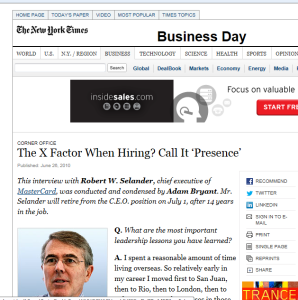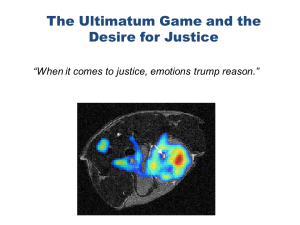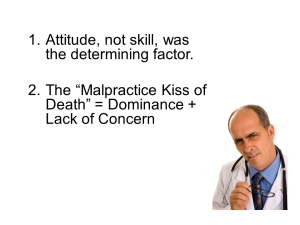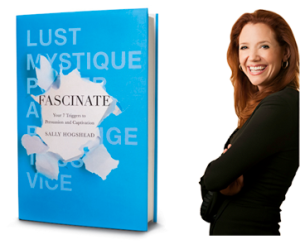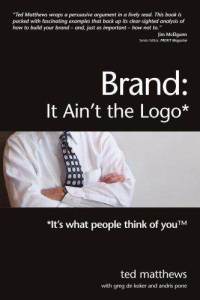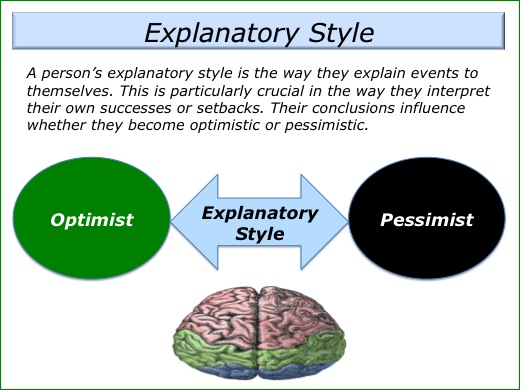Do you know how to fascinate–Part II: Ken Lubin and the Death Race
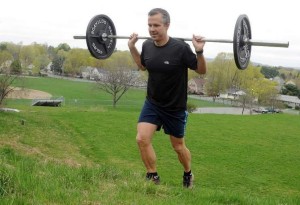 In an earlier post on fascination, we explored a bit about why it is mission critical to be fascinating, and how to get started on identifying what about you is fascinating.
In an earlier post on fascination, we explored a bit about why it is mission critical to be fascinating, and how to get started on identifying what about you is fascinating.
Now…let me give you an example: Ken Lubin, mild mannered (well maybe that’s a stretch) recruiter 9-5, absolute wild man before and after hours.
Ken was introduced to me by John Brubaker, who told me about this crazy guy who competed in the Death Race. I remember having read about the Death Race a few months earlier and was blown away by the idea anyone can endure, willingly, something so grueling. If you’ve ever read or watched any documentaries on Navy SEAL training or other Special Forces training, that’s the kind of intensity we’re talking about.
 Since I’m really into extreme fitness and fascinated by people who are far beyond my level, I knew I wanted to meet him, but also wanted to interview him for my work on resilience. I wanted to learn how he cultivates mental toughness.
Since I’m really into extreme fitness and fascinated by people who are far beyond my level, I knew I wanted to meet him, but also wanted to interview him for my work on resilience. I wanted to learn how he cultivates mental toughness.
I’ve interviewed him twice so far and I have to say, this guy is one of THE most fascinating people I’ve ever interviewed or talked with.
It was funny, talking with John Brubaker later about how much I enjoyed talking with Ken. I noticed that John, too said how intrigued he was by Ken. I found myself thinking–a la Fascinate–“That’s what any entrepreneur, speaker, sales person, or even job applicant” wants people to think about them.
If you want to make an impact, people have to CARE about what you have to say.
They need to find you fascinating.
Part of what makes you fascinating is being really passionate about something. Another part is when that something is really unusal.
To give you an example of this, let’s have Ken tell you first hand his experience in his second Death Race.
Besides being a cool story, it has some great lessons.
Notice how it makes you want to learn more about this person and what makes him tick, more about his perspective on facing challenges and adversity.
OK…enough of the preamble, let’s get to the story, after….
….I mention a webinar that will help YOU become more fascinating…
If you want to learn how to make your presentations (whether to a group or a one-on-one conversation) more fascinating and inspiring, check out the upcoming webinar Fascinating Inspiring U. If you can’t make it live, sign up and you’ll get the recording.
Whether you wnat to be a better speaker, a more inspiring leader, or a more compelling salesperson, this webinar will help you amp up your Fascination and Inspiration Quotient.
OK…noq doe Ken’s wild and wooly story….
Death Race 2012. The year of Betrayal. (How to quit and still win)
What an amazing race this was. It was totally unlike last year, easier in some ways and more difficult in others. But I can say it pushed me farther than I have ever gone before! I went 60+ miles on my feet, with an untold elevation gain and 53 hours of racing.
This year’s race had a theme of betrayal- which meant don’t believe anything any one says and the rules can change during the race.
During this race you will laugh, cry, and feel euphoria, dread and any other emotion that can come out of you. Also you will notice muscles you never felt, have blisters you never had, and feel beaten up like never before.
Throughout the race we were required to have with us at all times the following items: Needle, Thread, Life Jacket, Black Compression Shirt, Pen, Paper, Bag of Human Hair, pink swim cap, 5 gallon bucket, Axe
Last year I wrote about what I learned which was amazing, and this year I learned many new things, but I wanted to go into a detailed task by task summary of the race.
If you are offended by profanity, don’t read it. (It’s not too bad) But if you want to laugh and see how screwed up this thing is, have fun!
Pre Race warm up- farm duty, race briefing.
This consisted of chopping wood, raking, carrying big things and getting you tired in the hot afternoon sun. Next we had to do a swim and culvert training. (What is culvert training? Crawling 200 yards under the road in a pipe that is 3 ft wide and completely dark) Then for the race briefing, all 238 racers had to get in a freezing (spring fed, so it was cold) pond where the organizer dumped numbered ping pong balls into the pond. You had to grab a ball and find the other racers with the same number to form a team. This is how your team was set for the next 30 hours of the race.
Task 1. 22+ mile hike with heavy things (the start)
This year’s first task included carrying a large tractor tire, a Kayak, and/or a Pipe filled with 200lbs of water for 22+ miles on the long trail in VT. If you don’t know the Long Trail, picture going through a 2- 4 ft wide section of side walk with roots, rocks, trees, moss, and everything else you can imagine, with an enormous amount of climbing and descending. This task consisted of teams of 10-15 people carrying the above. During this time, the group at the back was told if they didn’t pass the next group, that they were going to be DQ’d from the race. (not true, as this was the year of Betrayal), but as you can imagine this created chaos and people were running with the above items. (Picture running of the bulls with these items above your head)
Task 2. Swim, buckets, hike
After carrying the insanely awkward objects for 22 miles, we were asked to swim about a qtr. of a mile. This was the most relaxing time of the event. What we didn’t realize is that we weren’t going to be able to get a resupply of food or water (except for the stream or reservoir) for the first 24 hours of the race. Many people including myself didn’t pack the appropriate supplies, but luckily I have a few extra pounds to burn (if you ever want to go on a diet, I suggest you try this for 24 hours). After the swim we had to carry 10 (5) gallon buckets of rocks about ¼ to ½ mile, which was again a welcome relief in comparison to the pipes and kayaks. Like I said above we had no food, but the race organizers where tempting us with pizza, donuts, sandwiches, if we would like to quit. I think a few people went down at this point.
Task 3. 12-15 mile hike back towards town (but not all the way)
We all thought that we were going to go back to base camp to get food and supplies, but that was not going to happen. We were led to a 2 hr exam which we had to take (exam in a death race??, yes). Imagine going full speed for 24 hours and then having to sit for 2+ hours, not very good for the muscles. Still no food, but water was given to us, but the same temptation of food was there if you wanted to quit.
Task 4. Hike back to town (ish)
Upon leaving this checkpoint, AKA Rodgers, we headed to what we thought was our base camp again, WRONG!!! We were lead back down to the valley but in the opposite direction of the most coveted food supply known to man. During one instance a support person dropped a couple of Gatorades and a bag of cookies on the ground and I have never seen so many people drop to the ground and look for crumbs. It was like dropping a bag of French Fries on the ground at the beach with a flock of seagulls around. This was at about hour 24.
Task 5. Race to the Top
We then get to the bottom of the next mountain, Joe’s Mountain, for a race to the top. We were told that if you were one of the last 50 racers that you were endangered of getting kicked out, I made sure I was up front. At the top of the mtn. our support crews were allowed to meet us. This was like a gift from god. Food, water, and hope all mixed together. Chaos ensued during this! Picture the seagull story from above with only 100 bags of fries and 1000 seagulls!!! (Pigeons, if you are not from the coast). My wife met us up there to supply me with food and was attacked. Some racer asked her if he could kiss her.
Task 6. Check in and go find your flag.
This is where the race broke wide open. I was able to hook up with 3 super strong racers for this task. Jeff Foster, PJ Rakoski and unfortunately I can’t remember the third. We had to check in, get a number and were then sent into the woods with a 5 gallon bucket of rocks and had to find the corresponding ribbon and dump the rocks in the holes where the numbers were. Fortunately for us, we found our flag right away; apparently many teams were there for hours and looking for their stick. (the race organizers have since admitted that there were moles moving them around, remember this was the year or Betrayal.) We had to make 2 trips up the final part of Joe’s mountain to dump our rocks.
Task 7. Chopping wood.
Holy shit!! I don’t think I have ever seen a tree this wide on the ground! Most often it is good to be in the lead, but not at this point. We were told that we needed to chop a piece of wood that was 40 inches long and 36 inches wide and then bring the whole thing back to the farm and rebuild it (the farm was 3 miles away, up and over the mtn.) This was mind blowing. We were also told that we needed just 12 pieces of wood 20 inches long. As this was the year of betrayal, I took the lesser of 2 evils. After much deliberation and receiving final clarification we got from the organizers. (mind f*ck) At this point we needed to carry the wood back over the top of the mtn. over to Amee farm, which is headquarters for the race.
Task 8. Origami
Origami, what the f*** is origami and why is it in this race. (but this is the death race). So back over the Mtn. we went to Borden’s farm. (Back over the mtn. was not just a trail over the mtn.). It was up a ravine with waterfalls, fallen trees, moss, and stinging nettles (they suck), all while still carrying the axe, bucket, life preserver and anything else that was on the mandatory gear list. Once we reached the next side of the mountain we were on to our next task, origami. Many of you don’t know me, but in order to draw a stick figure, I need directions. This was about 36 hours into the race at 2:30 am. This is where I paired up with my 2 compatriots, Don Schwartz and PJ Rakoski for the rest of the race. After an hour in the woods trying to memorize how to fold a “flying crane”, we took off to perform what we learned, we couldn’t move to the next task, if this wasn’t complete. My flying crane was awesome!!! We then had to split 10 logs and then back to Amee farm we went for the next task, (Amee farm was a 2 hour five mile hike, but we just rocked and rolled, it was great!)
Task 8: Concrete
Once we got back to Amee Farm at day break we were onto the next task. Bring a 60lb bag of concrete to the top of the Mtn. while still carrying all your stuff. So away we go. 60lb of concrete, 20lb pack, 2k vertical climb, back to the top of the mtn. Once at the top of the mtn., we dropped the bag off and headed back down. 2.5 hours round trip. Things are now starting to get a little fuzzy. I wonder why? (44 hours into the race, no sleep, 50 miles+ on foot) After retuning back to the farm we were told to go back over the same mtn, for the 3rd or 4th time to Riverside Farm, back corner of the field.
Task 9: The Vomit
This was the most insane thing I have ever done!! Not like everything leading up to this wasn’t but this blows it out of the water!!
As the leaders we get to farm first and saw that there was a course of tape about ¼ of a mile long made in the middle of a field which wasn’t mowed and the grass was 3 ft high, this is where the fun began! We had to roll the entire way. (Yes I said roll, on your side over and over again) We had to roll through grass, over rocks and trees, and under 200ft of a hot black tarp that was fully exposed to the sun. Oh and I forgot to mention the bucket of rotting animal organs we had to stir to get the smell going. (The tea cups at Disney make me sick) this was out of control. I don’t usually puke unless I have had huge amounts of red wine or beer, but I puked no less than 10 times during this. And we had to do 6 laps! I think I am still dizzy. Once we completed that task, we headed back over the mtn.. (seriously???). And for the rest of the people behind us except for us 3 and 4 more, this was the official end of the race.
After hiking over the mtn. and back down we were 3-4 hours in the lead and we thought this fucker was over!! As we were coming down there were 50+ people scattered all over the place that were on the verge of dying and heading up with the concrete that we did 2 tasks ago and they were 12-14 hours behind us.
PJ, Don, and I felt great; we were coming back to base camp and were ready for a beer, some dinner and being reunited with our support teams and loved ones but nope. We walked into check in and were told to go back over the mtn. with a bucket of rocks. Don, PJ and I knew that we were extremely fresh, felt great and that this thing could have gone on perpetually.
At this point we decided to call it quits. In our mind the race was over. We had done what we needed to do and crushed the field. It was 53 hours of stress we put on our wives, families and support staff and we couldn’t do that that any more. It was time to get back to life.
Many people are calling us quitters and that is fine!
What I learned is that while I love to race, train like a maniac and love to win, my life outside of this is more important. My family, my career, and next goals needed to be met. No we didn’t win and technically didn’t finish, my objectives were met. For the last year I have been training like crazy and I wanted to win this thing more than ever. I may not have won this, but I proved I was one of the best athletes and I am taking that away from this. So is it possible to quit and still win? I think it is!!
Lastly, I would like to thank all my support staff you all know who you are, PJ and Don, and all the race organizers for bringing me to a place, I have never been before. Also I would like to congratulate all the athletes if you finished or not, just getting in line for something like this is incredible!
______________________________________
David here…just a heads up… If you want to get better at this whole business of communicating in a powerful, fascinating way, I will be doing a workshop titled Fascinating Inspiring U in Maine of May 4th and a free webinar with the same title on April 24th
Check out the program descriptions:
The Maine Workshop:
http://storiesthatchange.com/fascinating-inspiring-u-workshop/
The Webinar:
http://storiesthatchange.com/fascinating-inspiring-u-webinar/
______________________________________
 More about Ken Lubin: I am a Managing Director with ZRG Partners www.zrgpartners.com and we are Global Executive Retained Search firm and I am based outside of Boston. I oversee a practice in Financial Services and have been working with key clients in identifying and placing individuals on a global basis. Currently I am working on searches in China, Hong Kong, Brazil, India, Singapore and the US. Also I have done a lot work in the emerging markets of Central and Eastern Europe and Latin America. I am also expanded my practice into the technology business as well.
More about Ken Lubin: I am a Managing Director with ZRG Partners www.zrgpartners.com and we are Global Executive Retained Search firm and I am based outside of Boston. I oversee a practice in Financial Services and have been working with key clients in identifying and placing individuals on a global basis. Currently I am working on searches in China, Hong Kong, Brazil, India, Singapore and the US. Also I have done a lot work in the emerging markets of Central and Eastern Europe and Latin America. I am also expanded my practice into the technology business as well.
Secondly I am passionate about Social Media and run 4 key groups on Linked In, one on Facebook, and you can follow me on Twitter.
1. Executive Athletes (9200 Members)
2. Boston Banking and Financial Services Professionals (6800 members)
3. Global Leasing and Lending Professionals (4500 members)
4. New York Banking and Financial Services Professionals (1100 members)
5. Executive Athletes on Facebook http://www.facebook.com/executiveathletes
6. Twitter @Executiveathlet
Moving into 2013 I am looking to take Executive Athletes, which was born out of social media, to a new level and have some great ideas to bringing some of the most passionate professionals and athletes I have ever known together. Also if you have any ideas about the growth and direction of the group, please let me know.
Most Importantly I love to bring awesome people together and please let me know if there is anything I can help you with. As always you can reach me at my desk at 508 366 5800 ext 219, my mobile at 508 733 4789 or my email at klubin@zrgpartners.com
Secondly there is a great book about Mental toughness that I am a fan of. Many of these I had, then lost when I didn’t trust myself and have regained over the last few years.
http://www.mentaltoughnesssecrets.com/

